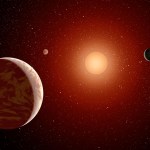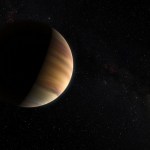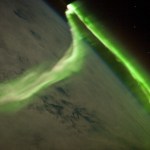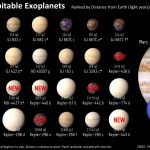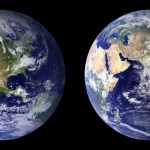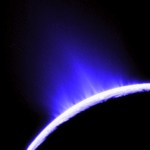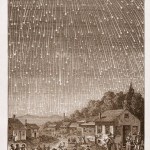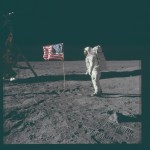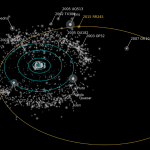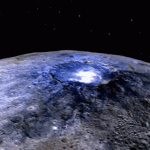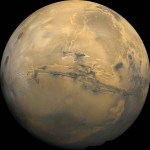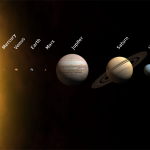Solar System
"I have lost tolerance for things without meaning. There is no time for them. Does that make sense?" -Sara Seager
The discovery of a potentially habitable planet around the nearest star to our own -- Proxima Centauri -- has brought up the tantalizing possibility that this might be closest Earth-like world ever found. But it’s important to realize that as much as we’d love to find a world humans could inhabit and colonize beyond our Solar System, there’s a big difference between calling something “Earth-like” and having it actually be like Earth.
An artist’s rendition of Proxima Centauri…
"What, I sometimes wonder, would it be like if I lived in a country where winter is a matter of a few chilly days and a few weeks' rain; where the sun is never far away, and the flowers bloom all year long?" -Anna Neagle
At some point in the future, the Sun, the giver and sustainer of nearly life on Earth as we know it, will run out of fuel. Powered by nuclear fusion, it turns hydrogen into helium, producing energy in the process. Yet the Sun has a finite mass, a finite rate-of-fusion, and someday will run out of hydrogen. When it does, bright as it may be today, it will cease to someday…
"How vast those Orbs must be, and how inconsiderable this Earth, the Theatre upon which all our mighty Designs, all our Navigations, and all our Wars are transacted, is when compared to them. A very fit consideration, and matter of Reflection, for those Kings and Princes who sacrifice the Lives of so many People, only to flatter their Ambition in being Masters of some pitiful corner of this small Spot." -Christiaan Huygens
With the big news about Proxima b and Kepler’s haul of over 3,500 new planets since its launch, the idea that planets orbit stars other than our own is so mainstream that…
“Concentrate all your thoughts upon the work at hand. The sun’s rays do not burn until brought to a focus.” -Alexander Graham Bell
In 1859, the Sun surprisingly increased in brightness so significantly for just a brief while that it was noticeable from Earth during the day. Less than 24 hours later, aurorae were visible so brightly and so far south that people awoke in the middle of the night, thinking it was dawn. But in addition to the spectacular sights, there were also downsides: telegraph wires spontaneously caught on fire, causing significant amounts of damage.
The atmospheric effects…
"Our existence in this place, this microscopic corner of the cosmos, is fleeting. With utter disregard for our wants and needs, nature plays out its grand acts on scales of space and time that are truly hard to grasp. Perhaps all we can look to for real solace is our endless capacity to ask questions and seek answers about the place we find ourselves in." -Caleb Scharf
Now that we’ve learned the nearest star to our Sun, Proxima Centauri, has a rocky planet at the right distance for liquid water, it’s time to consider how we might learn the answers to our burning questions about it and all…
“You develop an instant global consciousness, a people orientation, an intense dissatisfaction with the state of the world, and a compulsion to do something about it. From out there on the moon, international politics look so petty. You want to grab a politician by the scruff of the neck and drag him a quarter of a million miles out and say, 'Look at that, you son of a bitch.'” -Edgar Mitchell
Can you believe it’s been 70 years since humanity first began exploring our own planet from space? It’s the best way to view clouds, weather patterns, sea ice, deforestation and all sorts of other…
"All the atoms of our bodies will be blown into space in the disintegration of the solar system, to live on forever as mass or energy." -Carolyn Porco
Launched in 1997, NASA’s Cassini spacecraft has shed unprecedented views on our Solar System’s majestic, ringed world. From the discovery of new, outer rings to infrared hazes beneath its clouds to surprising storms, the nature of its rings and structure atop Saturn’s north pole, Cassini has delivered beyond any reasonable expectations.
A false-color image highlighting Saturn’s hurricane over its north pole, inside the much larger hexagon-…
"My dad took me out to see a meteor shower when I was a little kid, and it was scary for me because he woke me up in the middle of the night. My heart was beating; I didn't know what he wanted to do. He wouldn't tell me, and he put me in the car and we went off, and I saw all these people lying on blankets, looking up at the sky." -Steven Spielberg
This year’s Perseid meteor shower is already underway, and will peak on the night of August 11/morning of August 12. Consistently one of the year’s best, with approximately two meteors per minute and brighter than average meteors to boot, this year…
“I knew I was alone in a way that no earthling has ever been before.” -Michael Collins
Less than a decade after the first human was launched into space, astronauts Neil Armstrong, Buzz Aldrin and Michael Collins journeyed from the Earth to the Moon. For the first time, human beings descended down to the lunar surface, opened the hatch, and walked outside. Humanity had departed Earth and set foot onto another world.
Buzz Aldrin having just planted the first American flag on the surface of a world other than our own. Image credit: NASA/Apollo 11.
While Armstrong and Aldrin walked on the…
"This suggests a robust biological response. These analyses support the interpretation that the Viking LR experiment did detect extant microbial life on Mars." -Bianciardi, Miller, Straat and Levin
On July 20, 1976, the Viking 1 lander touched down onto the Martian surface, followed just a few weeks later by Viking 2. On board both landers were a suite of three experiments designed to look for signs of life.
NASA Viking Lander Biological Experiment Package. Image credit: NASA.
While the Gas Chromatograph-Mass Spectrometer and the Gas Exchange experiment both came back negative, the Labeled…
"There have only been two true planets discovered since ancient times, and this would be a third. It's a pretty substantial chunk of our solar system that's still out there to be found, which is pretty exciting." -Mike Brown, on the possibility of Planet Nine
When most people think of the Kuiper belt, they think of a population of objects just beyond Neptune, with slightly larger, more elliptical and more inclined orbits. As new discoveries like the recent 2015 RR245 show, however, there are a great many additional objects in the scattered disk with different orbital parameters that are much…
"It was the Venus I had prayed to, it was my prayer, though I had no such words. They filled my eyes with tears and my heart with inexpressible joy." -Ursula Le Guin
If you were to rewind the Solar System to the very beginning, with only imperceptibly different initial conditions, how often would Earth emerge looking like it does today: teeming with life? And how often would the other worlds -- Venus or even Mars -- emerge overflowing with stable, long-term life either instead or in addition to Earth?
Protoplanetary disks, which all solar systems are thought to form with, will coalesce into…
“Have you entered the springs of the sea? Or have you walked in search of the depths?” -Job 38:16
When NASA’s Dawn spacecraft discovered the existence of bright, white spots inside one of Ceres’ largest craters, the speculations ran wild, from water to aliens. Instead, it was determined that these highly reflective features are salts, likely deposited on Ceres’ surface fairly recently in this deep, less-than-100-million-year-old crater.
Image credit: NASA/JPL-Caltech/UCLA/MPS/DLR/IDA, converted from Nature Publishing Group press’s YouTube channel.
But new data, mostly in the infrared,…
"How well I have learned that there is no fence to sit on between heaven and hell. There is a deep, wide gulf, a chasm, and in that chasm is no place for any man." -Johnny Cash
The largest mountains, the greatest chasms, steepest cliffs and the tallest peaks on Earth are certainly impressive, particularly when compared to the scale of a human. But compared to the mountains on Mars, Io, Vesta or Iapetus, or the canyons and cliffs on Mars, Mercury, or even Charon, Earth’s features look puny.
Valles Marineris on Mars, taken by the Viking orbiters. Image credit: NASA.
How could these small…
“It used to be that Pluto was a misfit. Now it turns out that Earth is the misfit. Most planets in the solar system look like Pluto, and not like the terrestrial planets.” -Alan Stern
The combination of New Horizons and Hubble to work together allow us to create the longest-baseline parallax images of all time. Through this combination, we’ve managed to learn more about a distant, long-range Kuiper belt object -- in this case, (15810) 1994 JR1 -- than ever before.
New Horizons image of 1994 JR1, taken Nov. 2, was the then-closest-ever picture of a Kuiper Belt object. Image credit: NASA/…
"You can be the Moon and still be jealous of the stars." -Gary Allen
Earlier this week, NASA announced the discovery of Asteroid 2016 HO3, calling it Earth’s second moon. And it turns out that this is an object in a stable orbit, the same distance from the Sun as the Earth, that can be found revolving around our world at a distance between 38 and 100 times the distance from us to the Moon.
The orbits of all the known Potentially Hazardous Asteroids, as of 2013. This includes asteroids that have been gravitationally captured by the Earth-Sun system. Image credit: NASA/JPL-Caltech.
But that…
"The cosmic game changed forever in 1992. Before then, logic told us that there had to be other planets besides the nine (if you still count poor Pluto) in our solar system, but until that year, when two astronomers detected faint, telltale radio signals in the constellation Virgo, we had no hard evidence of their existence." -Thomas Mallon
For generations, if you wanted to know what the surface of the outermost known object in our Solar System -- Pluto -- looked like, you had to rely solely on your imagination. Sure, it was probably covered in ice, and large enough to pull itself into a…
“There is no question that climate change is happening; the only arguable point is what part humans are playing in it.” –David Attenborough
If the Earth didn't have any global warming at all, our planet's mean temperature would be 255 K, or about -1º Fahrenheit: the mean temperature of the Antarctic continent. As it stands instead, our planet is much warmer than that, owing to the warming, insulating effects of the atmosphere, which is largely transparent to (incoming) visible light, but traps a fair amount of the (outgoing) infrared radiation.
Natural color image of Venus from Mariner 10…
"We have known since the 1800s that carbon dioxide traps heat in the atmosphere. The right amount keeps the climate conducive to human life." -James Hansen
Thanks to our position in space, the energy output of the Sun, and the right atmospheric conditions on Earth, we have temperatures conducive to liquid water on our planet. Over the past 4.5 billion years, that's led to the flourishing and evolving of life, with our present existence marking something unlike anything else our planet's ever seen.
The very cold, polar regions of the Earth have a mean temperature far below the rest of the…
“A long time ago people believed that the world is flat and the moon is made of green cheese. Some still do, to this day. The man on the moon is looking down and laughing.” -Vera Nazarian
When people make claims that are patently untrue -- like the Earth is flat -- perhaps your knee-jerk reaction is to ridicule them. If you dig a little deeper, however, you'll likely discover a truth about your own past: that you once held views that flew in the face of the scientific evidence, only you weren't aware of it at the time.
During the partial phases of a lunar eclipse, the shadow of Earth can be…
